There was a comment below on the positions of Pathans genetically in relation to South Asians and Iranians. The “Pathan” samples are from Pakistan, while “Pashtun” are from Afghanistan. What you can see is that the “Pathan” samples are more like Punjabis, while Pashtuns are like Tajiks. The Iranian samples are from western Iran. You can see that the Pakistani Pathans are definitely a little closer to UP Brahmins than to Iranians. The Afghans are a bit closer to Iranians than UP Brahmins.
Here’s Treemix:
With 4 migrations:
With 6 migrations:
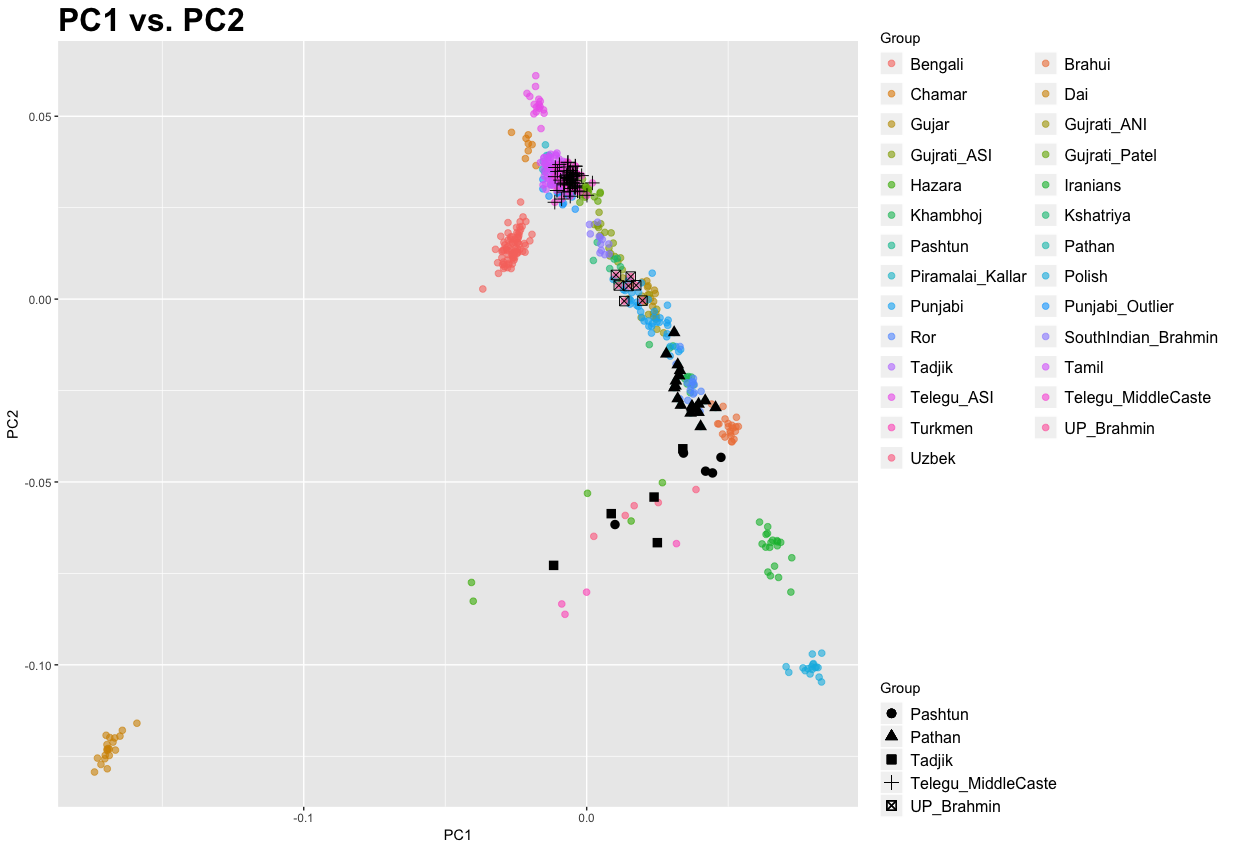
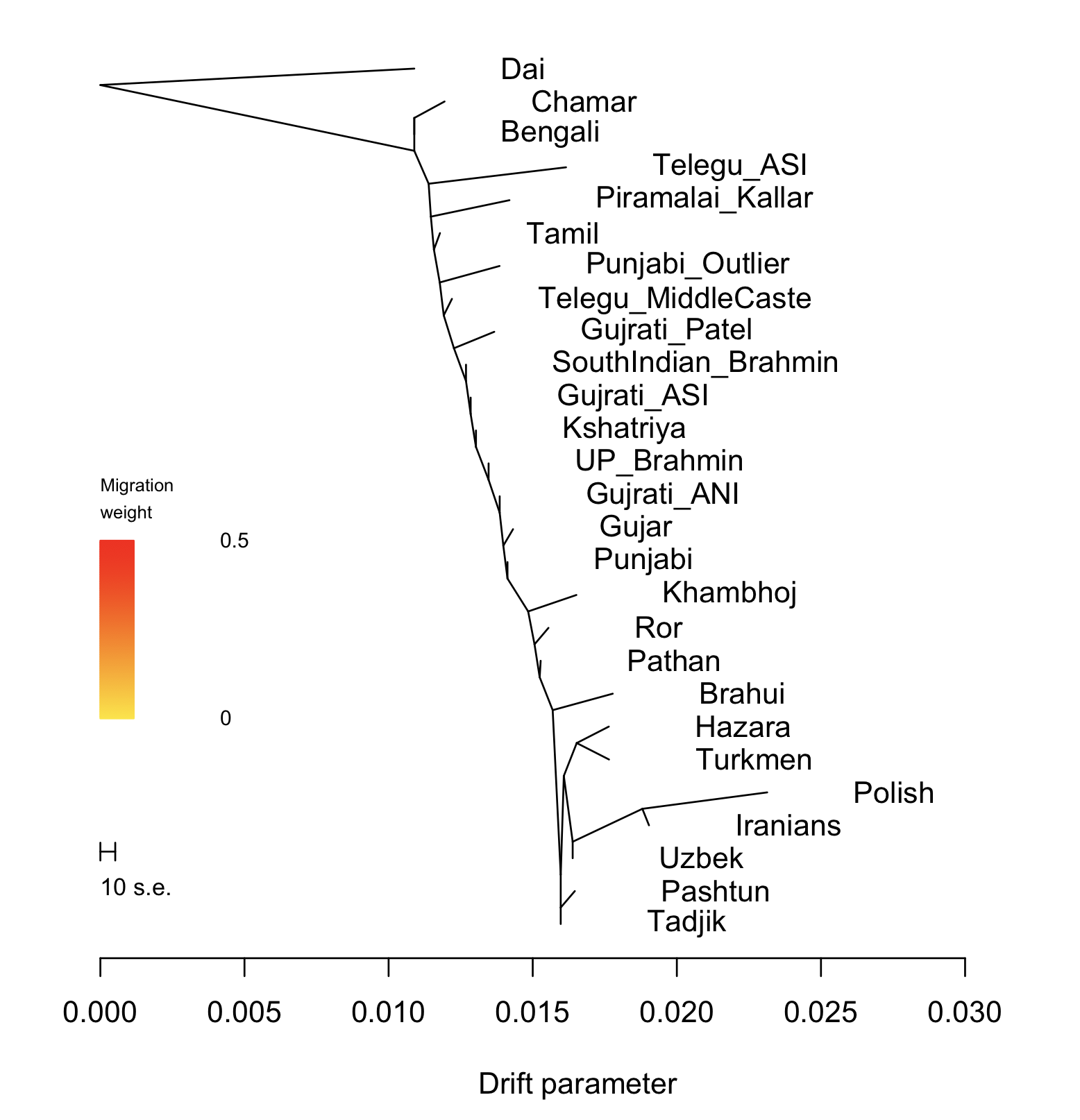
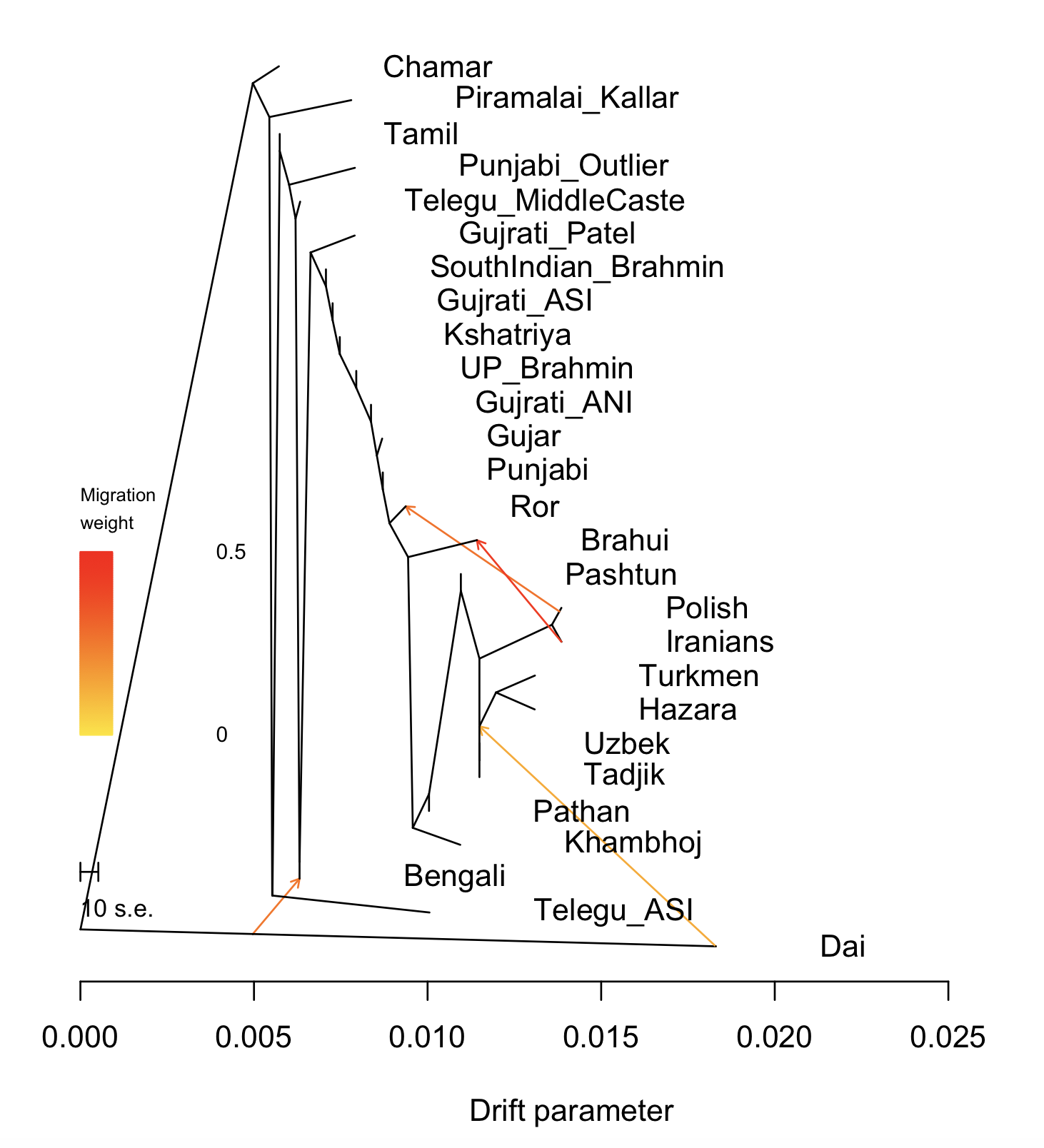
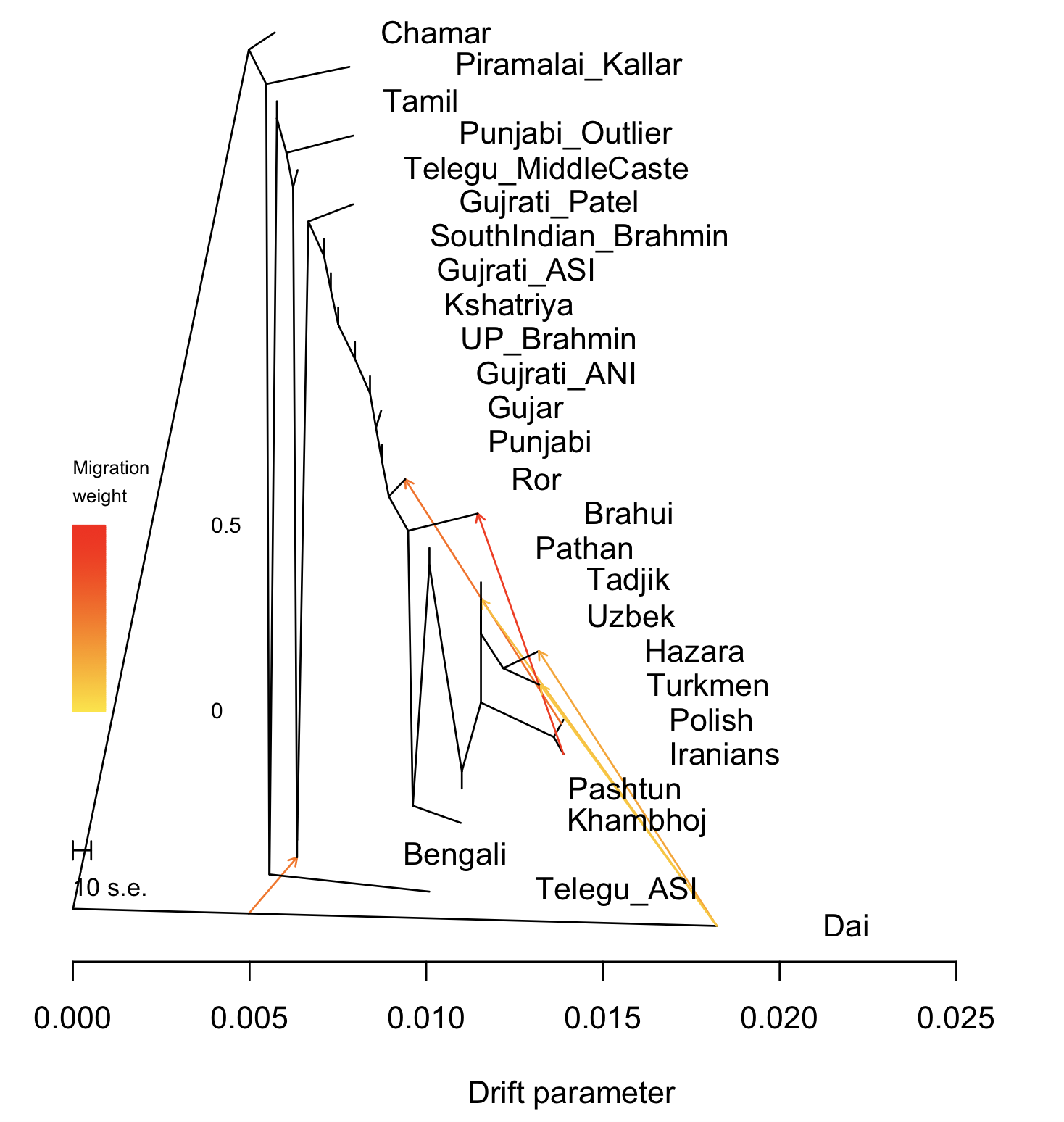
For whatever it’s worth, I have some fst distances on hand.
When it comes to the Pashtuns sampled in Pakistan (the Pathans of Razib’s post), the fst distance between them and Iranians is 0.006. Between them and north Indian Brahmins it’s 0.003. So they’re decently close to both, but a bit closer to the North Indian Brahmins.
Which is interesting, because as Razib noted, these Iranian samples are from the western part of that country. If the Iranian samples were of Khorasani extraction, there’s no doubt that these Pashtuns sampled in (what is now) Pakistan would be quite closer to them, rather than to north Indian Brahmins. So in genetic terms, these Pashtuns are quite liminal in the context of northern South Asia… too West Asian and Central Asian-like.
When it comes to the Pashtuns sampled in Afghanistan (the Pashtuns of Razib’s post), the fst distance between them and Iranians is 0.004. Between them and north Indian Brahmins it’s 0.007. An almost exact reversal: they’re decently close to both, but a bit closer to the western Iranians.
If we were dealing with samples from eastern Iran, these Pashtuns would be very close to them (I’m betting an fst distance of 0.002). Basically, in genetic terms, these Pashtuns fit rather smoothly into eastern West Asia and non-Turkic Central Asia, and are actually more similar to the peoples on the western end of the plateau than they are to West Eurasian South Asians (North Indian Brahmins are somewhere around 70% West Eurasian and 30% AASI/ENA. So in a broader sense, they’re basically West Eurasians).
Just to sum up: looking at the big picture, these Pakistani Pashtuns are liminal to northern South Asia, and do probably resemble eastern West Asians slightly more than they do northwestern South Asians, while these Afghan Pashtuns are basically a southern Central Asian/eastern West Asian population.
Interestingly, between each other these two sets of Pashtuns have an fst distance of 0.001. So they’re closest to each other, vs other populations. As they say in Pashto, “all Pashtuns are one”… lol.
The Indus Highlands only got Iranicized post 1000 AD
There have been many Iranian-speakers in the “Indus Highlands.” I’m not exactly sure what you mean by “Indus Highlands.”
But about around 200 AD, there were Kushanas who ruled Northern India, and they spoke an Iranian language. TO this day, the north of India uses their calendar, and today’s year is 1940 (https://en.wikipedia.org/wiki/Shaka_era) India also had Sakas rulers, who were Iranian.
“Pakistani Pashtuns probably resemble Eastern-West Eurasians more than Northern-South Asians.”
I don’t think so.
I’ve looked at data from both Razib and a myriad of other sources online, and it seems like Eastern/Pakistani Pashtuns cluster more closely to Sindhis and a section of Punjabis, than they do to any Iranic population. This includes Tajiks, the most Eastern-Shifted of Iranian peoples (more so than Khorasan-Iranians).
You’re misquoting me.
Anyway, when looking at genetic affinity, “Pakistani Pashtun” doesn’t really map unto anything.
For example, the Waziristani Pashtuns are genetically much closer to Pamiri Tajiks than they are to Sindhis and the West Eurasian Punjabis (the ones who happen to be around 80-85% West Eurasian, with significant Steppe_MLBA-related genetic ancestry. Like the Sikh Punjabi Jatts), and they count as eastern Pashtuns (they’re Pakistani). The same dynamic holds for the Afridi sample that I’ve worked with.
By contrast, the Afghan Pashtuns of Nangarhar, Kunar, and Laghman are slightly genetically closer to Sindhis and West Eurasian-type Punjabis vs Pamiri Tajiks, even though they count as western Pashtuns.
And the Tajiks of Afghanistan are virtually identical to Pashtuns. Some are similar to the “Pashtuns” of Razib’s post, and some are similar to the “Pathans” of Razib’s post (the Tajiks in Laghman are very similar to these “Pathans”). Yet, I don’t think you’d make much of that… you wouldn’t draw much of connection between Afghan Tajiks and Sindhis/Punjabis, despite the same dynamic one sees with Pashtuns.
I modified the quote to make it more cogent, but the gist is the same.
I’m not familiar with specific Waziristan samples, but I have seen Pamiri-Tajik samples, and they tend to cluster with Eastern-Pashtuns, Sindhis, and Punjabis. Within that cluster its possible Pamiris are slightly closer to Eastern-Pashtuns (like Waziristanis) than Sindhis/Punjabis, but they all still cluster together. Though we should be careful here, as the Pamiri region can run from the mountainous areas bordering Pakistan (prob where the above samples are from), all the way into mid-Tajikistan and parts of China depending on who you’re talking to.
You’ll notice I use the term “Eastern-Pashtun” rather than Pakistani-Pashtun, because I suspect (though can’t prove yet) the Eastern-Pashtun group that is Sindhi/Punjabi shifted doesn’t end at the borders of Pakistan, but bleeds well into Eastern-Afghanistan, bounded roughly by Kabul in the West and Abi-Istada lake in the South. Heck, this Indic-shifted Iranic-speaking area could run from the Hindu-Kush up through the Wakhan corridor, and include your above mentioned Pamiris.
I’d also disagree with the assertion that Tajiks are, “basically identical” to Pashtuns. I’d say they are a bit farther away from Paki-Pashtuns than Punjabis/Sindhis. They are closer to Afghan-Pashtun samples, but as I said above, I think you could probably further dissect Afghanistan to come away with additional Pashtun-areas that are closer to Sindhis/Punjabis than Tajiks or Eastern-Iranians.
You didn’t make it more cogent… you just changed the whole meaning.
Regardless, the Pamiri peoples do not cluster near Sindhis and West Eurasian-type Punjabis. Furthermore, all our samples are from Tajikistan.
The Afghan Tajik samples that I’ve worked with are virtually identical to western Pashtuns, with the exception of Laghmani Tajiks, and the two Kabuli samples which I have. The Laghmani Tajiks resemble eastern Pashtuns (as do the Kabuli Tajiks). Also, some of the Tajiks are more like Uzbeks or Turkmen (heavy East Asian admixture).
I find it hard to believe that Pathans and Pashtuns don’t have indigenous ancestry when Kabul was “Indian” little less than a millennia ago (my dates could be wrong).
@Zack
No, your dates are not wrong. However, Kabul was always *culturally* Indic, but genetically more diverse, as it did receive C Asian (and even Mediterranean) gene flow in various waves starting from the Greeks themselves. However, the local Indic culture absorbed successive waves of the feudal elite. It is a bit like how first Germanic Frankish tribes and later Normans went native in France.
The formation of the Persianate Samanid Empire and its co-option of various local Turkic tribes created the Islamo-Turk ghazi franchise which was so successful in Asia Minor and South Asia later. Sebuk-tegin (a local Kyrgyz warlord) and his son Mahmud of Ghazna started the process of invading hitherto pagan lands, ending the shahIya-s of Kabul. The coup de grace was dealt almost exactly 1005 years ago.
Kalhana writing only around a century after the event of the fall of shahIya-s claims that their destruction was near total, and resulted in turuSka hordes “descending like locusts”. So there must have been some serious de-population (massacres and flight of people) after the conquest. Certainly the shahIya house, whatever was left of them, sought refuge in Kashmir and as far south as Malwa. The acculturation was near total – similar to what happened in modern day Turkey (cf Ibn-Batuta’s Rihla).
(@Commentator jan, welcome back!)
I doubt the Turks were as destructive as the Mongols; to this day Central Asians still evidence heavy traces of Iranian ancestry.
I always feel that geographic factors (plagues or destruction of canals as in North Africa) have more of an influence on demography than warriors.
I agree, environmental factors have always done more damage than humans in societies living on the Malthusian tipping point.
However, to replace culture one did not need to kill off (or force out) all of the population. Just maybe the top 1-2%, i.e. the cultural elites. Once the elites that tied the culture of the region of the Northern riparian of the Indus tributaries to that of the Northern Gangetic belt were removed/replaced, the rate of cultural speciation was probably v quick. In 200-300 years the locals of Kabul had but the faintest memories of their Indic connections.
And with a new set of Timurid Turks (post-Ghenghis) coming into the picture, new connections formed between Kabul and India, but ones controlled entirely by Turks and in a totally new language and paradigm.
> the Afghan Pashtuns of Nangarhar, Kunar, and Laghman are slightly genetically closer to Sindhis and West Eurasian-type Punjabis vs Pamiri Tajiks, even though they count as western Pashtuns.
How are the Pashtuns of Nang., Kunar, and Lagh., considered Western Pashtuns when those provinces are literally the most eastern bound extent of Pashtunistan?
Iranian is such a misnomer. Modern Iran is so full of immigrants that its hard to talk of a ‘true’ Iranian identity. For instance, take the case of the recent paper (Grugni et al. 2012) on Iranian yDNA that was extremely comprehensive.
After reading that paper one gets a very clear idea that Iran is a genetic melting pot. There is no clear Iranian identity genetically except for Hg J2 perhaps.
That paper focuses so much on all the immigrant groups that the reader simply loses the thread on the real identity of ancient Persians or at least one can’t identify it without being confused amidst a host of different populations.
As a result, one can’t help but theorize on one’s own. It seems to me that the Iranian plateau was initially settled from the Indus valley, where the Baloch still have high amounts of J1 as well as J2.
The surname Al Balushi is still present and is well known among the gulf arabs where in Oman there are ministers with this surname. Interestingly, Oman is also the place that was the recipient of R1a from the indus valley. So, it indeed ties in
Further, the component used in current models by the terminology Iran_N (Iranian neolithic) also appears to be related to or derived from Mehrgarh neolithic, even though there may not be ancient DNA from Mehrgarh, yet. This is a perennial issue with modeling Indian populations
The movements I’ve talked of above have already been detected in the modeling of Shriner et al. 2016
Shriner and his team used a dynamic model that allowed for flow and detected an ancient migration out of the Indian subcontinent that interacted with the common ancestors of arabs, north and south Europeans in the middle and near east. They are of the opinion that this migration also explains the presence of a few India specific mtDNA haplogroups in north Africa
If I were to give my own opinion, I’d say the migration reported by Shriner et al. doesn’t just explain macrohaplogroup M mtDNA lineages in north Africa but also the massive presence of bos Indicus genome in cattle breeds all over the African continent as well as the traces of bos Indicus genome in southern European breeds.
Most probably that migration also puts a date on the separation of Iranian R1b from the western European clade of R1b
What does it mean ‘Polish’ on these diagrams?
genotypes from people who are polish.
Poland means – fields, Polish – people from the fields. The alternative name for them are Ljasi (or Lesi), it means – people from the forests. It is not very catchy name for one nation/state. The question is – how, when and where they got their position on this map in Iranian, Uzbek, Punjabi, Gujarati, etc, ‘neighborhoods’ and what was their name at that time? The correct answer would resolve many dilemmas raised in several this and last week’s Threads.
“What does it mean ‘Polish’ on these diagrams?”
May be this discussion from Eurogenes will answer your question.
http://eurogenes.blogspot.com/2018/04/bronze-age-central-asia-terra-incognita.html
“Rob said…
@ Mr Kulkarni
Reich is paying lip service
Anthony is everywhere in these Harvard papers
Which is why they are postHoc in their analyses
Hopefully the European labs come up with more intelligent theories”
“Mr. Kulkarni said…
@samuel
Reich is a geneticist.
“R1a Z93, mtDNA evidence, Andronovo, Scythian, Pathan, Kalash, Tajik DNA are really what confirm Indo Iranian languages are from the Steppe.”
lol wut? dna speaks languages now? do share what you are smoking.
Steppe entry into Swat is too little, too late for Vedic aryans.
Sorry bro.”
Directly from Dr. Reich’s mouth:
The most authentic articulation of the genetic evidence for the Aryan Invasion Theory. Scroll down to the 50 min mark.
https://www.youtube.com/watch?v=990052wQywM
Quoting at 52:34
“Today’s steppe ancestry ranges from zero to thirty percent of the ancestry in South Asia today.”
Between ZERO to 30%, and that too has been inferred from some outliers in Swat valley. if I understand the earlier parts accurately.
Let us see what the expert geneticists of this blog have to say.
Hi Mayuresh,
The range he’s given is too low as he didn’t know about the latest developments.
Couple of Haryana populations have 60-70% steppe component and neither of them is R1a heavy
The problem with Lazaridis’ solution or any method that models modern Indians using steppe bronze age is heavy circular referencing. Right from ANE to CHG none of the components they use to build steppes BA are free of possible Indian contributors. A fact that is hard to prove unequivocally in the light of abysmal aDNA sample collection from the subcontinent
Hi Anurag:
“Right from ANE to CHG none of the components they use to build steppes BA are free of possible Indian contributors”
A dog wagging its own tail then? From a layperson’s perspective it appears that the geneticist presume some version of the AIT and then force their models into it. Check out this picture for example
There are two very long arrows shooting up from Iran to Yamanaya, and Khavalynsk and then after a few thousand years they come down to Asia (ever so conveniently) within the philologically derived time frame of 1500 BCE. To complicate things further there is a long arrow from Iran going to IVC also in the earlier farming era; This kind of genetical merry go round allows placing the homeland anywhere in that quadrilateral one would think.
Oh, just noticed the arrows going from the west of BMAC (Turan) upto Afansivo and by passing Andronovo to the area of reconstructed Tocharian languages. What the heck?
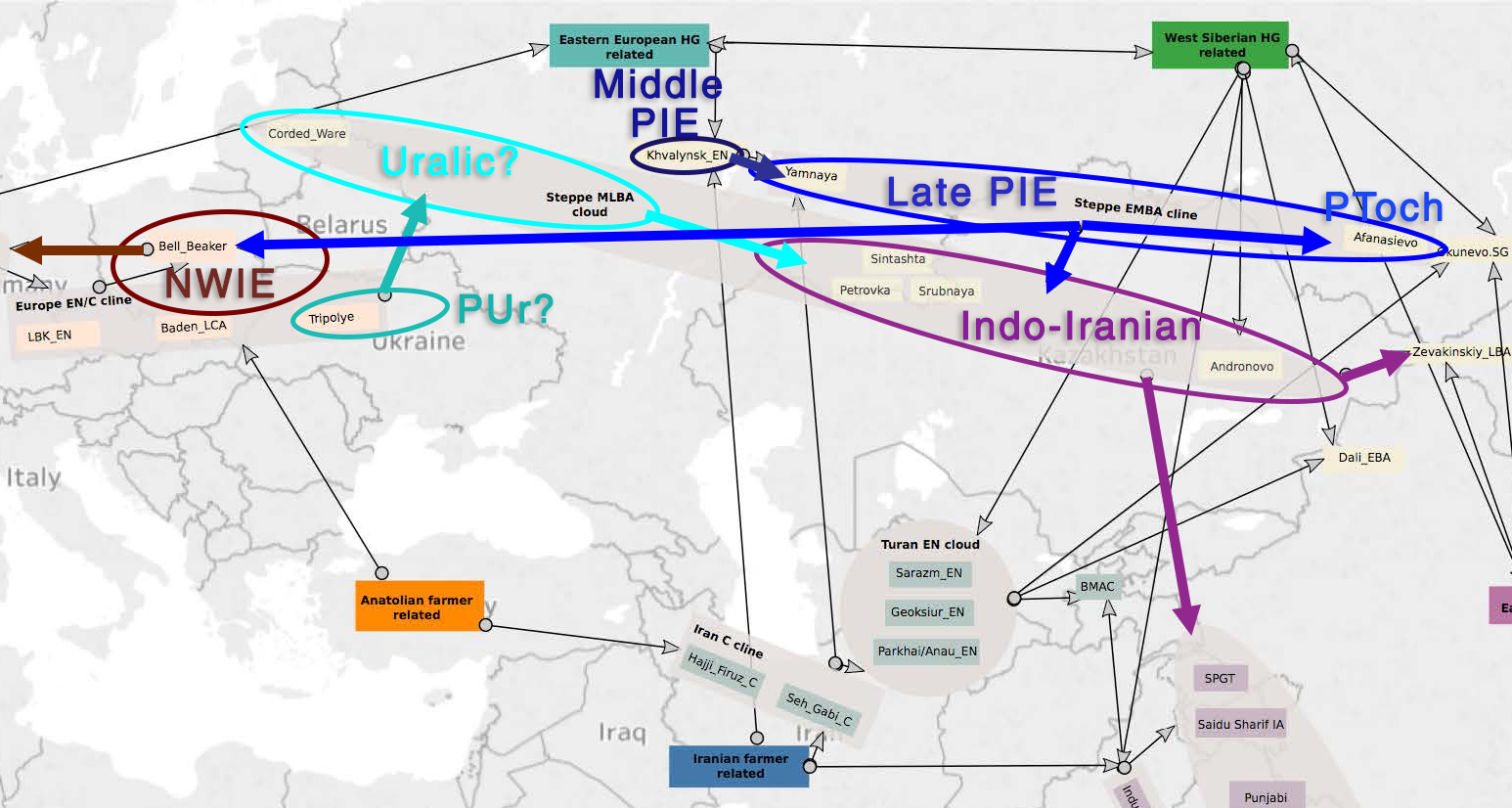
They conveniently ignore Professor Luders and Stein who both reached very different conclusions compared to these Steppes PIE theorists about Kanishka, the Kushans and their ancestry.
Professor Luders was very clear in his conclusion that Kanishka was from the Rouzhi (Yuezhi) social group that emigrated to Loulan in Tarim Basin from Roruka in the Indus Valley
The ancient DNA from Tarim Basin mummies show several India specific lineages quite clearly. In a way, we can connect Professor Luders work and the ancient DNA from Loulan and quite legitimately teach a viewpoint against the Gimbutas (PIE from Steppes) school in Indian textbooks. I hope we’d try to convince the government
” historically attested Tocharian languages”
Reconstructed proto tocharian actually.
Hi Mayuresh,
Also consider the fact that the Makranis can be modeled as more than 95% Iran neolithic
In Iran, I don’t think there is any group with that sort of association to Iran_N
It’s our hard luck we haven’t extracted any aDNA from Mehrgarh, yet. Else, we can straightaway show an Indo-Iranian continuity since the neolithic and all these bronze age PIE models would be redundant